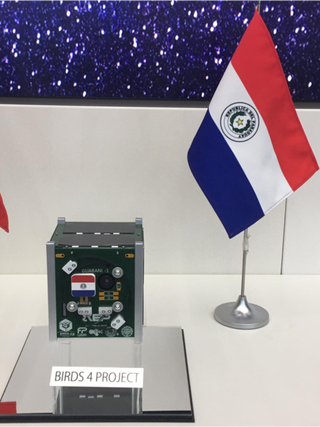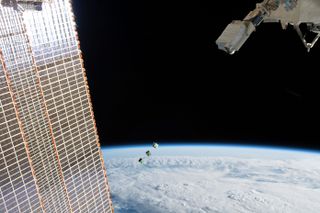Paraguay's 1st satellite is in orbit after launch from space station
The name of the satellite pays homage to Guaraní, the indigenous-derived official language spoken in Paraguay.

Earth has a new spacefaring country: Paraguay.
On March 14, the nation's first-ever satellite entered orbit around Earth, deployed from the International Space Station (ISS) as part of a collaboration with a Japanese university. The satellite was built by two Paraguayan engineering students in conjunction with an international program, according to a NASA statement about the satellite.
The name of the satellite likely pays homage to Guaraní, the indigenous-derived official language spoken in Paraguay as well as in parts of Brazil and Bolivia. (The language shares this official status with Spanish, which is spoken throughout most of the continent.)
Related: Only total solar eclipse of 2020 thrills spectators in South America

Guaranísat-1 is a small spacecraft of the type known as a cubesat and it will orbit for up to two years, according to NASA.
Paraguayan aerospace engineering students Adolfo Jara and Anibal Mendoza developed Guaranisat-1. Jara is a Ph.D. student and Mendoza is obtaining a master's degree at Kyutech, or the Kyushu Institute of Technology in Japan. Kyutech facilitates the Joint Global Multi-Nation Birds Satellite project, or BIRDS, a program that is also supported by the Japanese government and its space agency, JAXA.
BIRDS supports space engineers in nonspacefaring nations, according to NASA; Guaranísat-1 is part of the fourth iteration of the program.
Get the Space.com Newsletter
Breaking space news, the latest updates on rocket launches, skywatching events and more!
Previous satellites launched through the program came from Ghana, Bangladesh, Mongolia, Bhutan, Nepal, and Sri Lanka. "Participating countries pay for student training, satellite hardware, and launch. The space station provides a low-cost option for launching satellites, helping to keep the program affordable," NASA officials wrote.
The satellite is primarily a technology demonstration. It is equipped with a camera to take images from space, and uses artificial intelligence to sort pictures for efficient, cost-effective downloads.
The Paraguayan scientists also installed sensors onto Guaranísat-1 that can detect the presence of the triatomine bug, also called the kissing bug. This insect carries the parasite that causes Chagas disease, which infects about 8 million people in Mexico, Central America and South America, according to the Centers for Disease Control and Protection (CDC). The infection is often undiagnosed and can be fatal.
"Data from those sensors will be automatically transmitted via a central hub to the satellite and downloaded by a ground station to create a map of disease risk," NASA officials wrote in the statement. "Health authorities can use this map to help determine prevention actions."
Guaranísat-1 entered space via the Japanese Experiment Module Small Satellite Orbital Deployer-16 (J-SSOD) aboard the space station last week.
"Our country's first satellite marks a historic moment," Alejandro Román, who manages the "Paraguay to Space" project at the Paraguayan Space Agency (AEP). "It is the first step in a long path to bring the benefits of space to Paraguay in areas like disaster risk reduction, agriculture, natural resources management, land management and climate."
Follow Doris Elin Urrutia on Twitter @salazar_elin. Follow us on Twitter @Spacedotcom and on Facebook.
Join our Space Forums to keep talking space on the latest missions, night sky and more! And if you have a news tip, correction or comment, let us know at: community@space.com.

Doris is a science journalist and Space.com contributor. She received a B.A. in Sociology and Communications at Fordham University in New York City. Her first work was published in collaboration with London Mining Network, where her love of science writing was born. Her passion for astronomy started as a kid when she helped her sister build a model solar system in the Bronx. She got her first shot at astronomy writing as a Space.com editorial intern and continues to write about all things cosmic for the website. Doris has also written about microscopic plant life for Scientific American’s website and about whale calls for their print magazine. She has also written about ancient humans for Inverse, with stories ranging from how to recreate Pompeii’s cuisine to how to map the Polynesian expansion through genomics. She currently shares her home with two rabbits. Follow her on twitter at @salazar_elin.
